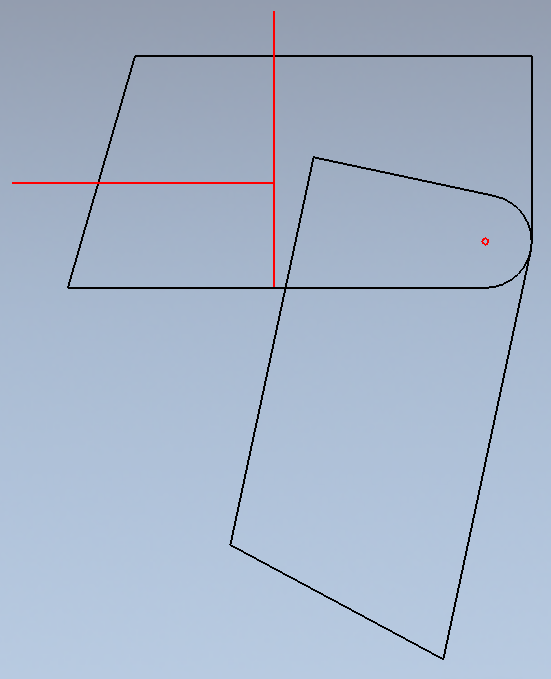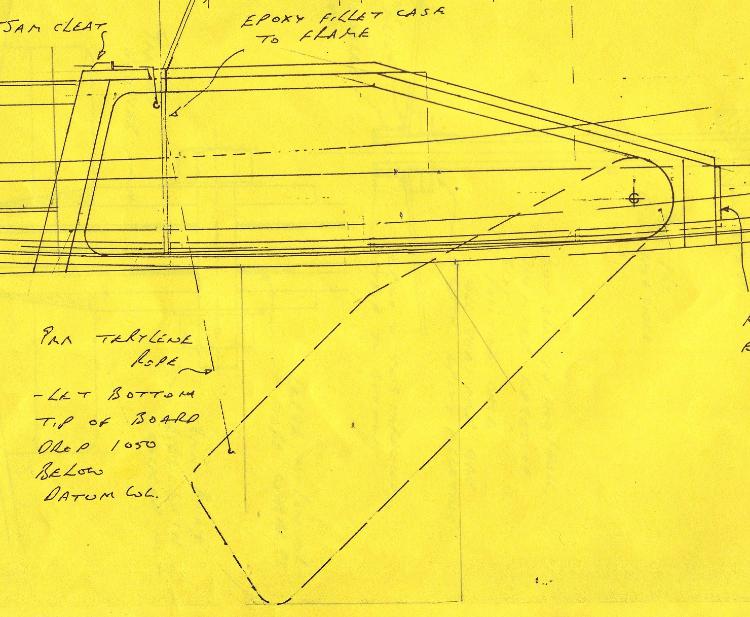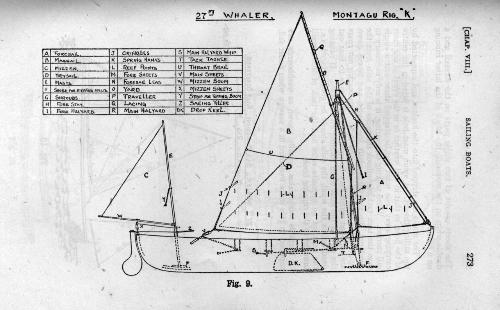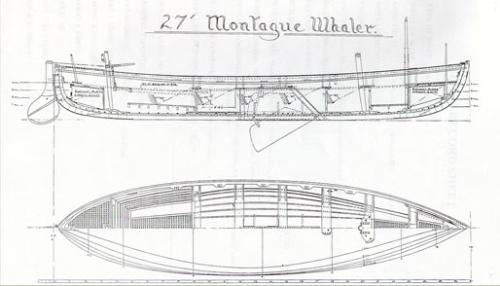Casting lead for a centreboard
12
12

|
Paul H (admin) |
Casting lead for a centreboard
|
|
MilliBee's new centreboard weighs 5kg and will displace 9L when lowered. It is 1m by 0.5m.
Displacing 9 litres will give 9kg of floatation upwards and gravity gives 5kg downwards - so there is a net uplift of 4kg preventing the board from lowering. In other words 4kg of weight would give the board neutral flotation So what weight do I need to add, to ensure the board lowers fully? The original plans specified a thinner but longer board and 15lbs (7kg) of lead cast into the board. Has anybody cast lead into a centreboard? Could I use a steel plate screwed to the wooden board instead? -cheers Paul |

|
Peter Nobes |
Re: Casting lead for a centreboard
|
|
Hi Paul
I've never tried it, but I saw on a canoe-sailing website someone made a hole in his leeboard and, instead of using molten lead, filled it with lead shot and then poured epoxy into it. Best Peter On 15 April 2013 13:10, adminHBBR [via UK HBBR Forum] <[hidden email]> wrote: MilliBee's new centreboard weighs 5kg and will displace 9L when lowered. It is 1m by 0.5m. -- Peter Nobes Teacher of the Alexander Technique London UK www.alexandertech.co.uk www.facebook.com/AlexanderTechniqueLondon www.youtube.com/ZenForOurTime South Bank Alexander Centre www.AlexanderCentre.co.uk 020 7928 6378 |
|
|
In reply to this post by Paul H (admin)
Lead has advantages: it's heavier so you'll need less of it than you would steel. It doesn't rust and you can embed it inside the centreboard and shape it with plane (maybe not your best one) to keep the hydrodynamics the same. Melting lead and pouring it was easier than I expected to be when I did it, though it's a process that deserves huge respect. Be prepared for every possible sort of disaster by covering yourself with protection, doing it outdoors, making sure the burner/pan etc. are very stable, etc. As it cools it does shrink so you still have to dribble (or syringe) thin epoxy in around the casting to lock and seal it in place. Never gone the slab of steel bolted to the board route. You could consider going the whole way and getting the board made in galvanised steel. Serious righting moment, bomb proof and no bouyancy issues. The dagger board on Ardilla is just wood with a bungee tie down. You could consider just having a board with positive bouyancy and having a hold down (that releases if you hit bottom) system instead of the ballast. Perhaps that's a temporary solution to go afloat with to test your bouyancy calculations! Of all those ideas somehow casting the lead seems the 'proper' way to me, but I'm not the one that will have to do it! Tim. On 15 Apr 2013, at 13:10, adminHBBR [via UK HBBR Forum] wrote: MilliBee's new centreboard weighs 5kg and will displace 9L when lowered. It is 1m by 0.5m. |

|
alopenboat |
Re: Casting lead for a centreboard
|
|
In reply to this post by Paul H (admin)
On 15 Apr 2013 at 5:10, adminHBBR [via UK HBBR Forum] wrote:
> > > /MilliBee's/ new centreboard weighs 5kg and will displace 9L when > lowered. It is 1m by 0.5m. > > Displacing 9 litres will give 9kg of floatation upwards and gravity > gives 5kg downwards - so there is a net uplift of 4kg preventing the > board from lowering. In other words 4kg of weight would give the board > neutral flotation > > So what weight do I need to add, to ensure the board lowers fully? The rudder on Little Jim displaces about 4.5 litres and has 3kg lead cast into the trailing edge about 550mm below the pivot. Never had a problem with it lifting except when hitting the bottom. > > The original plans specified a thinner but longer board and 15lbs > (7kg) of lead cast into the board. Has anybody cast lead into a > centreboard? I had no problem. I cut a notch out of the trailing edge, screwed in a couple of screws into the thickness of the wood to act as keys, clamped on a temporary backing board and poured in the lead. Clean up with a surform and glass over. > Could I use a steel plate screwed to the wooden board > instead? Probably. -- Hoping for calm nights Alastair Law, Yeovil, England. <http://www.little.jim.freeuk.com> |

|
alopenboat |
Re: Casting lead for a centreboard
|
|
In reply to this post by Peter Nobes
On 15 Apr 2013 at 6:25, Peter Nobes [via UK HBBR Forum] wrote:
> > > Hi Paul > > I've never tried it, but I saw on a canoe-sailing website someone made > a hole in his leeboard and, instead of using molten lead, filled it > with lead shot and then poured epoxy into it. > > Best > Peter You could fit a brass bead down the trailing edge and clip on some car wheel-balance weights :-) If using molten lead make sure the wood is dry! -- Hoping for calm nights Alastair Law, Yeovil, England. <http://www.little.jim.freeuk.com> |
|
|
In reply to this post by Paul H (admin)
Just checking: the only part of the centreboard that counts flotation wise is the bit that's actually in the water. So I assume that is 9 litres of submerged board (1 metre deep by 50 cm fore/aft and average 18mm thick) weighing 5kg.
Tim.
On 15 Apr 2013, at 13:10, adminHBBR [via UK HBBR Forum] wrote: MilliBee's new centreboard weighs 5kg and will displace 9L when lowered. It is 1m by 0.5m. |

|
Paul H (admin) |
Re: Casting lead for a centreboard
|
|
Yes 9 litres submerged volume (including the portion inside the case but below W/L). I totally agree with all the safety tips, there are some very risky lead casting videos on You Tube. I'll be using: full face mask, welding gloves, woolly hat, old skiing jacket, heavy boots, thick long socks, many layers of clothes, clean and dry wood and mould materials Should I epoxy seal the wood first? It probably helps. Thanks for all the feedback. -Paul |

|
Port-Na-Storm |
Re: Casting lead for a centreboard
|
|
In reply to this post by Paul H (admin)
Paul, Do you want a) Ballast, b) just to keep the centreboard down, or c) do you really just need an excuse to pour some lead?
If you need Ballast, you'll need an awful lot more than 4kg to make any difference. If you want to stop your centreboard floating up then a bit of shock cord and a cleat will do that. Remember if you add even 4kg of weight to the centreboard you'll need to beef up the pivot bolt to take the extra strain when trailing, you'll also need some kind of lifting and cleating tackle to keep it up. If you want an excuse to pour lead, then I'd check the price of scrap first then have a look on embla's Blog for his brilliant descriptions of firstly making Ingots , then pouring the Keel, then trimming it with a Chainsaw! Such Fun. http://emblasail.blogspot.co.uk/2012/11/lead-smelting.html |

|
Paul H (admin) |
Re: Casting lead for a centreboard
|
|
Graham,
b) and especially c) 
Due to the pivot being 100mm from the board front (exactly as per the Enterprise) shock cord would have a mechanical advantage of 0.2 and need to provide 20+kg of force. It would also have to curve around the board and be anchored under the pivot when retracted - basically it's impossible to make it work as reliably as gravity. A shiny piece of solid 12mm stainless bar arrived today, more than strong enough to hold the total weight. The case sides will be doubled up to 18mm or more and a centre roller supports the board on the trailer. The lifting force will be no worse than her old steel+wood bilge boards, I thought I might need tackle but a vertical lift was easier than expected. One is usually standing up, fearful of the impending crunch on the shore or an embarrassed stall in the sand - nothing moves quicker than a frightened man with a rope. -Paul |

|
Randonneur |
Re: Casting lead for a centreboard
|
|
In reply to this post by Timmo
On Mon, Apr 15, 2013 at 2:35 PM, Timmo [via UK HBBR Forum] <[hidden email]> wrote:
You mean you could buy this? (see below) Pete
So - anyone who is going to build a bilge keel Lynx or who wants a galvanised swing center board for any other design drop me a line. regards Ian |
|||||||||

|
Paul H (admin) |
Re: Casting lead for a centreboard
|
|
Pete, Thanks for that but the board has already been made and shaped according to Cee Dubs' technical brief to make it "fish like" - round at the front and pointy at the back! 18 mm laminated ply, I'll glass it after the lead is cast. -Paul |

|
Chris Waite |
Re: Casting lead for a centreboard
|
|
....Or you could just put a sqeezed polythene tube friction device on it?
  Difficult to adjust unless you can get at the squeezing screw though. The other trick is a continuous uphaul-downhaul line loosely through eyes mounted by the head of the board in its retracted and extended positions. A loop like this can be pulled either way to raise or lower the board and as it goes through the two eyes there is usually enough friction to counteract the tendency to float. Again, difficult to mount in a case that has a closed forward end in the cabin CW |

|
Paul H (admin) |
Re: Casting lead for a centreboard
|
|
Unfortunately because the pivot is low and forward a handle or rope attachment cannot swing the board through 90 degrees. Here is a sketch, the red lines are the cockpit floor and main bulkhead. The top of the case supports a bridge deck level with seating, which gives maximum board area:  I can't think of an alternative design that would work with a handle/rope without taking up more cabin space - but last minute suggestions are welcome. Paul |
|
|
Paul
Looking at your diagram, I can see that it is not so easy and a weight at the bottom aft corner of the centreboard is the easy option. However, since you set a challenge, my sugestion for an alternative is a strong elastic cord wrapping round the radius of the top front corner of the board then vertically up the front of the case to a pulley to turn it in a direction to lead to a handy cleat, probably with a rope extension actually gripped by the cleat. I agree that the lever arm against which the tension in the elastic works is quite small, but as the board becomes more vertical the lever arm of the bouyancy force also reduces to compensate. My guess is that it would be fine with strong enough elastic, or perhaps a loop of strong elastic round a small pulley, that way you close to double the pull of the elastic for a given pull that you need to exert at the cleat. As I see it, the advantage of using elastic rather than a weight on the board is that if the board wont go down due to sideways water pressure you can just pull harder. With a weight, if the weight is not heavy enough there is nothing you can do about it. As you pull harder on the elastic the braided sheathing over the rubber will effectively become a rope. Time to think about going sailing again soon! |

|
Chris Waite |
Re: Casting lead for a centreboard
|
|
In reply to this post by Paul H (admin)
I agree Paulie
You have a conundrum. Either it will have to be seriously heavy and need an uphaul within the case - same as 'TW'. If it does bind when the pressure comes on it, then it will usually drop with the motion of the next few waves; if not, then luffing momentarily. Or you will need to have the top of the forward part of the case, within the cabin open and fit an extended arm long enough to stick out when it is fully extended. Make your eyes water trying to sit on it though Problems, problems CW |

|
Port-Na-Storm |
Re: Casting lead for a centreboard
|
|
This is a bit like a Murder mystery game where they only feed you clues after you've solved each puzzle.
Every time you guys solve a problem Paulie feeds in another clue. So, to re-cap. Paul wants to sink a centreboard which weighs in at 5kg and has a volume of around 9 litres so needs another 4kg to give it neutral buoyancy. The general geometry, and the mindset of the owner are not conducive to down-hauls or friction brakes. So weight is the preferred option with an as yet undisclosed additional weight to sink it and keep it sunk. (No Bobbing). The C/B case is half inside the cabin, and half under the bridge-deck. I'm presuming that big holes in the case within the cabin are a bad thing. CW says it needs to be seriously heavy, how serious is that? 10kg.15kg 20kg ?? Any tackle used to raise the board will need to support its dry weight for when its not actually afloat. How about a drum winch set inside the bridge-deck to one side of the centreboard case. Have the drum off to one side with the tail of the pulling rope fed through a hole in the bridge-deck to a cleat, handy for the helm. The shaft of the winch would run right through the case with a big notch cut out of the trailing edge of the board to make room. No one will see. Drill a big hole in the bridge deck near the aft end of the case so that the blunt end of a boat-hook can solve any jamb. Wayne knows how well this works. One line to operate, no holes in the case within the cabin, Not quite simple but workable. I await the next set of clues which will throw us off again. |

|
alopenboat |
Re: Casting lead for a centreboard
|
|
On 16 Apr 2013 at 14:13, Port-Na-Storm [via UK HBBR Forum] wrote:
> So, to re-cap. Paul wants to sink a centreboard which weighs in at 5kg > and has a volume of around 9 litres so needs another 4kg to give it > neutral buoyancy. The general geometry, and the mindset of the owner > are not conducive to down-hauls or friction brakes. > > So weight is the preferred option with an as yet undisclosed > additional weight to sink it and keep it sunk. (No Bobbing). The C/B > case is half inside the cabin, and half under the bridge-deck. I'm > presuming that big holes in the case within the cabin are a bad thing. > > > CW says it needs to be seriously heavy, how serious is that? 10kg.15kg > 20kg ?? My rudder, at about half the volume, uses 3kg lead and reliably stays down. Remember the epoxy/glass coat will sink. > Any tackle used to raise the board will need to support its dry weight > for when its not actually afloat. My uphaul is a bit of string working on a 200mm radius. -- Hoping for calm nights Alastair Law, Yeovil, England. <http://www.little.jim.freeuk.com> |

|
Paul H (admin) |
Re: Casting lead for a centreboard
|
|
This post was updated on .
In reply to this post by John P
John, Chris,
John made a good point about the buoyancy force diminishing as the board angle increases. My concern is that to raise the board fully vertical the bungee has to wrap round under the hull...just ready to run into mud, gravel and sand. Whatever attaches it to the board will be vulnerable at the point. The contingency plans are for lowering the board when jammed by mud and gravel, the worst case scenario. This happened to me twice, once on Poole beach when we landed a Wayfarer for a cup of tea on the beach, watching the waves gently lap up the sunny beach. A postcard picture .....but little did we know each wave was packing sand and gravel around the shaped centreboard, wedging it into the case. When we set off we could not lower the board. We then had to beach her, roll the hull on her side to access the board. After about 30 minutes messing around with screwdrivers and a hammer we freed it.....lesson well and truly learned! MilliBee's swing bilge keels jammed with mud at Cobnor - you know, that awfully muddy patch to the left of the hard. But I had a length of wood that fitted in the case slot that opened in the cockpit - careful use of that most precision tool a hammer freed it in about 30 seconds. Likewise this new board will have a removable flap at the bridge deck, so that a lever can push the board down just behind the bulkhead, about 60% from the pivot. For reference the old L shaped bilgeboards weighed 15kg each and needed 10kg force to lift each in the cockpit, which I did without any pulleys, just a rope and jam cleat. Apart from mud they lowered successfully. So I think I can handle my new weighted board. Here is Paul Fisher's weighted (15lbs/7kg) centreboard option, 1400 x 400 mm. I didn't choose this design because 1) it extends a long way into the sleeping area 2) there won't be much "lift"? I pencilled my board location, hopefully with a wing-like trailing edge it will give good lift. My cockpit is 100 mm higher, hence I made my board 500 mm wide and shorter with 90 degrees of swing.  -Paul |

|
Chris Waite |
Re: Casting lead for a centreboard
|
|
My insomnogram has had another thought
The old Naval Montagu Whalers:   had the same problem and a heavy centreplate - galvanised steel. A tad OTT for your circumstances, but the clever bit was a steel bar with a 'T'-ish handle; actually it was more like a squashed 'Q' so that you could get your hand inside it and avoid trapping the pinkies. You can see it in the diagrams above - better on zoom. This was pinned to a tab extending off the trailing edge of the plate, but (just about) within the depth of the case and when retracted, the tab protruded through a hole in the top allowing the handle to fold flat along the top of the case itself. A removable pin through the tab held it housed when not in use. Extract the pin and the galvanised steel dropped like anything; taking the steel bar with it as far as the handle. Clunk - quite a lot; unless you held it and lowered it more gently. Yours could even be used to push it down, as well as pull it up. The 'hammering-hole' in the top aft end of the case remains a useful addition.... And if big enough, a conveninent place to lower one's own equipment When 'pumping-ship' yourself CW |

|
Paul H (admin) |
Re: Casting lead for a centreboard
|
|
Some useful ideas there Chris...I'll aim for about 8kg of lead, if it jams a lot I can always add more.
Which brings me to a key point - where do I get scrap lead from? -Paul |
«
Return to General Discussion
|
1 view|%1 views
| Free forum by Nabble | Edit this page |

